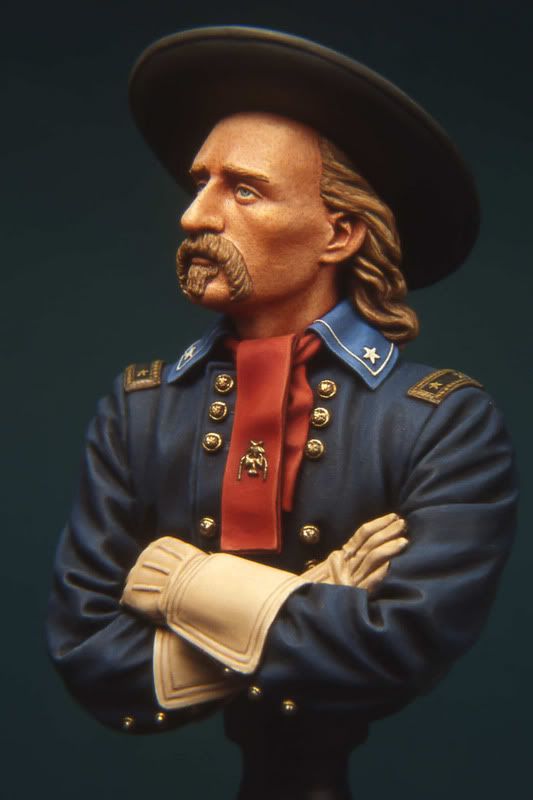bonehead said:
The sculpting at McFarlane toys is the very best out there, no doubt. The painting of these production pieces is quite good too. But it is a "style" that runs counter to the accepted "norm" among figure painters.
...
Surface effects will achieve a certain fool the eye realism. As a closet model builder, this kind of effect is the height of achievement in making models.
I wasn't suggesting that there should be any move toward zero shading

apart from the fact that we generally paint a lot smaller to begin with the best of the large-scale painters whose work I've seen don't paint without any shading. IMO the best of them do just enough, the weaker stuff being very evident for either a lack of or stylised or 'mannered' lighting (too soft usually)
bonehead said:
For one, the "artistic" style has morphed into a sort of caricature or cliche of itself in that the style has been pushed to such extremes that great contrast has become the "ultimate litmus" in determining what is the "best" of the breed. While there certainly is a great deal of skill displayed by many of our painters, my personal feeling is that, taken to extremes, the style moves quite far away from any reasonable expectation of "fool the eye" realism as displayed by these well produced toys. To some extent it has become a sort of formalized fiction, which we have all agreed to accept simply by participating.
I feel much the same. Any painting method that could be considered some form of special effect should be reserved for exactly that -
special effects. Not used on e v e r y t h i n g one paints (especially where it's not appropriate anyway!), not used by itself, or even excessively on a single figure.
Far too often, as we've seen in a couple of cases, it tries to hide or divert attention away from limitations in other areas - like on Russian studio stuff, where the patterning can be superb (ignoring whether it's anachronistic or excessive) but practically always it is combined with so-so or even downright weak fleshtones, faces!!
bonehead said:
To top it off, many practitioners move even further away from realism when they choose paints which do not give the proper realistic finish: dead flat for clothing, egg shell for leather and skin, bright polished effects for metal and high gloss for those bits which require it. Too often figures display beautiful painting techniques, but the finished piece has a consistent semi-matte, or even dead flat finish which runs counter to any attempt at realistic depiction of surface texture.
As you know I feel the same way about that too.
On a round figure even at a small scale even slight gloss differences sell the representation of different materials in a way that painted illusions of reflections almost always fail to do as well; as we've talked about before, viewing in the round even the very best painted lighting effects fall down for many viewers, where appropriate gloss does exactly what it's supposed to do,
enhance the overall effect.
bonehead said:
For me, ideally, the ultimate would be something between the fabulous surface effects shown by these great toys, and the over-wrought highlight and shadow displayed by so many figures.
Agree 100%.
carl reid said:
I think it's a case of the figure is not always the finished piece the photo is.
Yep, that's often the case. What I can't get my head around sometimes is when views of the model in the flesh don't see that there's something lacking. Fundamentally I think
taste drives judgements far more than it should (far more than it's supposed to in written judging guidelines for example); we've seen this continuously for as far back as I can remember.
Brent Fordham said:
There are those aircraft modelers who strive to paint as closely as possible to the color and texture of the 1:1 subject. For example, if the real subject aircraft has a uniform color (new and unfaded) they will paint their model in a uniform color that replicates the original color as closely as possible. I believe however, that in doing so, they discount the effect of scale distance.
I totally agree. You just can't paint a 1/32 scale model and a 1/72 scale version of the same thing in exactly the same colour and have them look equally good. Just as gloss level needs to be adjusted for smaller scale usually.
Would it be fair to say that those who use real-world paint chips as
the standard for scale paint would also tend to be those who don't want as much weathering, don't use as much/any colour modulation, have their aircraft pristine or nearly so?
Brent Fordham said:
I feel that a degree of excessive contrast is needed to fool the viewers eye into seeing detail and texture that really isn't there. The pursuit of this is something that I'm currently playing with now in aircraft finishing. I was always impressed by a painting that Shep Paine referenced in his book, "Building and Painting Scale Figures" ... He shows how the painter fools the viewer into seeing detail on the helmet that really isn't there by "cleverly positioning highlights and shadows". When you look closely at the helmet in the painting, it's just a bunch of squiggles!
There's a difference though between painting sculpted detail in a given way and painting onto a featureless flat surface where the paint is
solely responsible to show 3D modelling.
Lots of modellers use painted-in detail/modelling in some way, but it's a separate issue to over-painting (my opinion) basic folds and creases with excessive, and often simultaneously misplaced, highlights and shadows.
Einion











